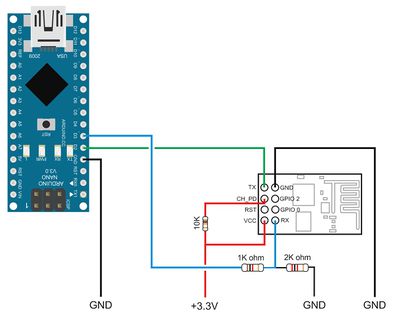Differenze tra le versioni di "ESP8266/collegamentoarduino"
Jump to navigation
Jump to search
(Creata pagina con '400px Siccome le uscite di Arduino sono a 5V, bisogna utilizzare un partitore di tensione per abbassare la tensione sulla TX da Arduino che va...') |
(Nessuna differenza)
|
Versione delle 21:40, 27 mag 2015
Siccome le uscite di Arduino sono a 5V, bisogna utilizzare un partitore di tensione per abbassare la tensione sulla TX da Arduino che va alla RX del ESP8266
Sketch
// Basic serial communication with ESP8266
// Uses serial monitor for communication with ESP8266
//
// Pins
// Arduino pin 2 (RX) to ESP8266 TX
// Arduino pin 3 to voltage divider then to ESP8266 RX
// Connect GND from the Arduiono to GND on the ESP8266
// Pull ESP8266 CH_PD HIGH
//
// When a command is entered in to the serial monitor on the computer
// the Arduino will relay it to the ESP8266
//
#include <SoftwareSerial.h>
SoftwareSerial ESPserial(2, 3); // RX | TX
void setup()
{
pinMode(LEDPIN, OUTPUT);
Serial.begin(9600); // communication with the host computer
//while (!Serial) { ; }
// Start the software serial for communication with the ESP8266
ESPserial.begin(9600);
Serial.println("");
Serial.println("Remember to to set Both NL & CR in the serial monitor.");
Serial.println("Ready");
Serial.println("");
}
void loop()
{
// listen for communication from the ESP8266 and then write it to the serial monitor
if ( ESPserial.available() ) { Serial.write( ESPserial.read() ); }
// listen for user input and send it to the ESP8266
if ( Serial.available() ) { ESPserial.write( Serial.read() ); }
}
cambiare la velocità del seriale in base al firmware del ESP8266
